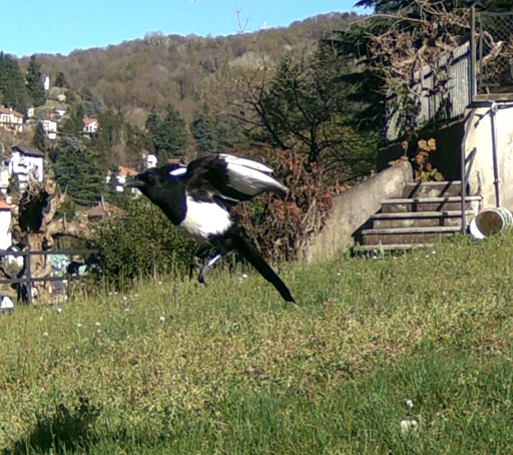The Magpie (Pica pica) is a striking bird in the crow family (Corvidae), easily recognizable for its black and white plumage and long, iridescent tail. Widely distributed across Europe, Asia, and parts of North Africa, it is known for its intelligence and complex social behavior. The magpie has a body length of 44-46 cm and a wingspan of 52-60 cm, with an average weight of 220-250 grams.
Adults are characterized by their black-and-white feathers, with a glossy black head, chest, and tail contrasting with white wings and belly. The long tail is one of the bird's most distinctive features, shimmering in various colors depending on the light. Juveniles are similar in appearance to adults but have duller plumage.
Scientific Classification
Kingdom: Animalia
Phylum: Chordata
Class: Aves
Order: Passeriformes
Family: Corvidae
Genus: Pica
Species: Pica pica
Physical Characteristics and Structure
The magpie has a slender, robust body that is perfectly adapted to its omnivorous diet and varied feeding habits. Its wings are long and pointed, enabling it to perform rapid and acrobatic flight, often characterized by quick, erratic movements followed by gliding. The tail is long and wedge-shaped, which aids in flight stability and maneuverability.
The beak is straight and strong, designed to crack open nuts and seeds and to forage for a wide range of food, including small invertebrates, eggs, and occasionally small vertebrates. The magpie's legs are strong and designed for walking, perching, and occasionally running on the ground in search of food.
Physical Properties
Pica pica typically measures between 44 and 46 cm in length, with a wingspan ranging from 52 to 60 cm. The weight of an adult bird is between 220 and 250 grams. The magpie's flight is relatively powerful, and it is capable of flying long distances when necessary. The bird is also known for its behavior of hopping or running across the ground when foraging for food.
The striking black-and-white plumage, especially the iridescent tail, is one of the most distinctive features of the magpie, giving it a sleek, elegant appearance. The long tail is a prominent characteristic that is often spread out during displays or in flight, adding to the bird's visual impact.
Reproductive Process and Biological Cycle
The magpie is monogamous, forming long-term pair bonds. The breeding season typically begins in spring, with pairs establishing and defending large, tree-based nests. The female lays between 4 and 8 eggs, which are incubated for about 17-21 days, depending on environmental conditions. Both parents are involved in incubation and the care of the chicks.
Once hatched, the chicks are altricial, meaning they are born blind and helpless. The parents feed the chicks with a diet that includes insects, seeds, and small invertebrates. After approximately 3-4 weeks, the young magpies fledge, leaving the nest but often staying within the parents' territory for some time before becoming fully independent.
Magpies are known for their ability to build large and elaborate nests, which are often constructed in the branches of tall trees. These nests are made of twigs, mud, and other materials, and they are lined with softer materials to protect the eggs and chicks from the elements.
Ecology and Environmental Role
Pica pica plays a significant role in its ecosystem, both as a scavenger and a predator. It feeds on a wide variety of food, including seeds, fruit, small animals, insects, and the eggs of other birds. The magpie is also known for its habit of collecting shiny objects, which it sometimes adds to its nest, earning it a reputation for being a "collector" of objects. This behavior is thought to be linked to their high level of intelligence and curiosity.
In terms of ecological impact, the magpie helps control insect populations and plays a role in seed dispersal. Additionally, by scavenging for food, it helps to clean the environment and prevent the accumulation of waste in some areas.
Magpies also have an important role as prey for predators, including larger birds of prey and carnivorous mammals. While not a primary food source for many predators, their young and eggs can be vulnerable to predation.
Environmental and Conservation Considerations
Pica pica is widely distributed and is not considered a threatened species. It thrives in a variety of habitats, including woodlands, farmland, parks, and urban areas. However, as with many birds, the species can be affected by habitat loss and changes in land use, particularly the destruction of wooded areas or the loss of suitable nesting sites.
In some regions, magpie populations may be controlled due to their perceived impact on other bird species, particularly in the case of predation on the eggs of smaller birds. However, magpies play an important role in the ecosystem, and their presence is often considered beneficial for controlling pest populations.


